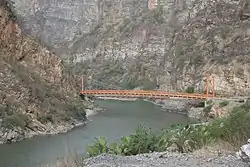Curahuasi
Qura Wasi | |
|---|---|
 Bridge across the Apurímac River on the border of the regions Cusco and Apurímac between the districts Curahuasi and Mollepata | |
| Country | |
| Region | Apurímac |
| Province | Abancay |
| Founded | January 2, 1857 |
| Capital | Curahuasi |
| Government | |
| • Mayor | Danilo Valenza Calvo |
| Area | |
| • Total | 817.98 km2 (315.82 sq mi) |
| Elevation | 2,688 m (8,819 ft) |
| Population | |
| • Total | 18,556 |
| • Density | 23/km2 (59/sq mi) |
| Time zone | UTC-5 (PET) |
| UBIGEO | 030104 |
Curahuasi District is one of the nine districts of the Abancay Province in Peru.[1]
Geography
One of the highest peaks of the district is Q'illu Q'asa at approximately 4,600 m (15,100 ft). Other mountains are listed below:[2]
- Aqu Q'asa
- Chaka Chaka
- Chunkara
- Chuqi Marka
- Ch'illkani
- Ch'uru
- Chhullunku Pata
- Inka Pirqa
- Kiska Pata
- Kunturillu
- Mulli Kamayuq
- Mulliyuq
- Muru Qucha
- Nasa Q'ara
- Pirwata
- Puka T'uyuyuq
- Pukara
- Quri Phaqcha
- Q'iwiri
- Silla Q'asa
- Tika Qaqa
- T'asta Q'asa
- T'utura Qucha
- Urpi Utt'aña
- Urquni
- Waman Ayri
- Waman Marka
- Wank'a Wank'a
- Warmi Awqa
- Wasa Qhata
- Wichinka
- Wik'uña Kunka
- Wik'uña Utt'aña
- Yana Qucha
Ethnic groups
The people in the district are mainly indigenous citizens of Quechua descent, although with a sizable percentage of mestizo and castizo population located mainly in the urban center.
Quechua is the language which the majority of the population (73.79%) learnt to speak in childhood, 25.86% of the residents started speaking using the Spanish language (2007 Peru Census).[3]
Climate
| Climate data for Curahuasi (elevation 2,741 m (8,993 ft), 1991–2020 normals) | |||||||||||||
|---|---|---|---|---|---|---|---|---|---|---|---|---|---|
| Month | Jan | Feb | Mar | Apr | May | Jun | Jul | Aug | Sep | Oct | Nov | Dec | Year |
| Mean daily maximum °C (°F) | 21.9 (71.4) |
21.3 (70.3) |
21.3 (70.3) |
22.2 (72.0) |
22.7 (72.9) |
22.3 (72.1) |
22.0 (71.6) |
22.9 (73.2) |
23.5 (74.3) |
23.8 (74.8) |
24.3 (75.7) |
22.6 (72.7) |
22.6 (72.6) |
| Mean daily minimum °C (°F) | 11.0 (51.8) |
11.0 (51.8) |
11.2 (52.2) |
10.3 (50.5) |
8.8 (47.8) |
7.5 (45.5) |
7.0 (44.6) |
7.6 (45.7) |
8.9 (48.0) |
9.9 (49.8) |
10.3 (50.5) |
10.7 (51.3) |
9.5 (49.1) |
| Average precipitation mm (inches) | 134.2 (5.28) |
132.3 (5.21) |
105.5 (4.15) |
38.5 (1.52) |
6.4 (0.25) |
2.0 (0.08) |
4.4 (0.17) |
10.3 (0.41) |
11.7 (0.46) |
53.6 (2.11) |
80.6 (3.17) |
124.3 (4.89) |
703.8 (27.7) |
| Source: National Meteorology and Hydrology Service of Peru[4] | |||||||||||||
See also
References
- ↑ (in Spanish) Instituto Nacional de Estadística e Informática. Banco de Información Digital Archived April 23, 2008, at the Wayback Machine. Retrieved April 4, 2008.
- ↑ escale.minedu.gob.pe/ UGEL map Abancay Province (Apurimac Region)
- ↑ inei.gob.pe Archived January 27, 2013, at the Wayback Machine INEI, Peru, Censos Nacionales 2007, Frequencias: Preguntas de Población: Idioma o lengua con el que aprendió hablar (in Spanish)
- ↑ "Normales Climaticás Estándares y Medias 1991-2020". National Meteorology and Hydrology Service of Peru. Archived from the original on 21 August 2023. Retrieved 6 November 2023.
14°03′43″S 72°40′12″W / 14.062°S 72.670°W
This article is issued from Wikipedia. The text is licensed under Creative Commons - Attribution - Sharealike. Additional terms may apply for the media files.